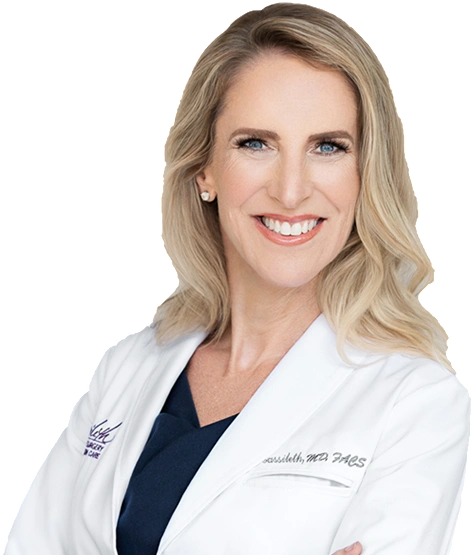
Breast Implants Gone Wrong
Top Breast Augmentation Surgeons in Beverly Hills
Breast implants can cause trouble. We all know that in rare cases they can rupture and need to be replaced, but other postoperative breast implant complications are common as well: bottoming out, capsular contracture, rippling, double bubble, and malposition, to name a few. There are also cosmetic concerns that can affect a patient’s self-esteem: breast size that is too small or too large, asymmetry, poor implant placement, or a breast shape that is out of proportion.
We believe that breast enhancement should improve your self-confidence and overall well-being. As breast reconstruction specialists, fixing breast implant problems is what we do. Each problem requires a different technique, but it's critical to control the location and quality of the implant using the capsule, with the enhancing addition of mesh and/or dermal matrix. We'll review each problem and the solution. And don't worry... every problem can be fixed! The repairs that let you keep your implants are below; but remember, you can always remove your implants. For that solution, check out our implant removal page.
Board-Certified Beverly Hills Plastic Surgeon, Breast Specialist, and Direct-to-Implant Breast Reconstruction Inventor
"Bottoming out" means that your implants are sitting too low. They usually sit too lateral as well, causing the implant to go to the sides and under the arms when you are lying down. You may notice:
The capsule, the natural layer that normally forms around every implant and keeps it in place, is too thin in patients with this problem. That's why suturing the capsule (capsulorrhaphy) doesn't work –- the thin tissue just gives way again. I've also seen plastic surgeons try to pinch out some skin to hold the implant up! You should definitely not allow this, as you will have a big scar, and it doesn't work at all! We recommend instead enhancing the capsule to make it stronger. In this case, we use Galaflex® mesh. Although officially absorbable, Galaflex is thin and tough. As your body absorbs the mesh within the first year after surgery, an area of texture and strength develops where the Galaflex used be, essentially replacing your thin capsule with a more functional capsule that can actually hold up the implant.
Double-Board-Certified Beverly Hills Plastic Surgeon and Breast & Body Specialist
Capsular contracture occurs when the capsule, which is the natural scar tissue that forms around every implant, is too thick. The thick scar tissue will start to contract, and the space for the implant will become too small for the implant to fit. Although this causes the implant to feel hard, it's actually not; it's just so highly compressed that it feels hard. The capsule, however, may often become hard and even brittle; it's not uncommon to find calcifications in the capsule, like an eggshell. There are various factors that can cause capsular contracture, so it's important to be able to resolve the underlying issues so the capsular contracture can be truly fixed. The four most common causes are:
Some patients' bodies have a tendency to over-react to the presence of implants, and they create tight, thick capsules around them. In these patients, you will always see bilateral (on both sides) contracture, as the inherent problem is the way your capsule is formed. In this case, your capsule should be removed, in a procedure called a total capsulectomy.
Contracture caused by biofilms is often unilateral (only on one side), and is more common with incisions that are through the areola, armpit, or umbilicus (belly button), as the bacteria gets onto the surface of the implant easily through these types of incisions. They also can appear after implant revision surgery, as they are more likely to get on the implant the more surgeries you have. Either way, the biofilm needs to go. We recommend a complete capsulectomy (removal of the capsule) in addition to removal of the implant, followed by our antibiotic powerwash. We use a cellular dermal matrix ("ADM") to cover the new implants. This is purified human dermis, and has no living cells. It is a soft, supple sheet-like material, and keeps the interface between your body and the implant soft and healthy. It controls the implant position as well, so the breasts stay symmetric. The ADM we like in these cases is Cortiva®, which has a low incidence of allergy and red breast syndrome. We don't recommend Strattice™, as it is made from a bovine (sheep) source, and can occasionally cause longer-term reactivity and allergy.
Bleeding in the implant pocket during or after your original breast augmentation surgery is a form of trauma that can cause contracture. Blood is inflammatory and occasionally, instead of resorbing normally, it can cause a long-lasting hematoma (old blood in your implant capsule) that in turn causes capsular contracture. These capsules need removal and implant replacement with the use of ADM, and drains are placed in surgery to allow any blood that forms after surgery to exit the body.
Implant rupture, specifically that of silicone implants, can cause contracture. Further, if your capsule was left behind during a prior surgical attempt to treat an implant rupture by removing the affected implant, microscopic silicone may still be present in the capsule, and can cause the contracture to recur. We have had patients who told us that their prior surgeon said that they were now "cleaned out," only to find later that the silicone was still present in the current capsule. Silicone is usually inert, though, so why does the continuing presence of silicone matter? In some patients, the silicone can cause an immune response and capsular contracture. Therefore, the entire capsule needs removal, called a total capsulectomy, and the new implants should be covered with ADM to keep them soft. New implants should be cohesive silicone or saline only.
Rippling is simply the implant showing through the skin, and happens in women who are thin and don't have a lot of breast tissue. It's most common to see on the sides of the breast, especially when you lean over, but it can happen in any thin location. If the implant is saline, the easiest fix is to switch to cohesive silicone. Silicone implants ripple less than saline implants, especially the full cohesive silicone models. Even silicone can ripple, though, so the real fix is make sure there is a thick layer of subcutaneous fat covering the implant. If the implant is in the right position, a small amount of fat can be grafted over the rippling area. Most of the patients that ripple need fat in other locations as well for best aesthetics, for example, the cleavage area. The fat acts as an all-around breast naturalizer. If the implant is in the wrong position, like too low or to the sides, this needs to be fixed at the same time.
"Double bubble" occurs when a patient's implant falls too low, and you can see the bottom of the breast (the first bubble) and then the bottom of the implant (the second bubble). This happens when the surgeon lowers the "inframammary crease" (the bottom of the breast) in an attempt to make the implant look more natural. It's most common with patients who have a naturally high crease, like those with tuberous breast deformity.
Fixing a double bubble involves two steps: first, correcting the position of the implant. Second, correcting the position of the breast tissue. The implant position can be controlled using a mesh. The mesh can support the implant in any position that is most aesthetic. We then cover the breast with soft tissue. The way we do that depends on the patient, and can range from fat grafting to repositioning breast tissue, depending on the patient. For tuberous breasts, we can unroll the thick breast tissue found behind the areola for great coverage of the implant, and this also helps us to shrink the areola to a more natural size and shape.
Malposition means that the implant is simply in the wrong place. Sometimes, implants just heal a little too high or too low. Simple malposition can be fixed with capsulorrhaphy, and may need reinforcement with mesh if the natural capsule is too thin to hold.
Since your implants are under your pectoral muscle, the muscle was cut away from the ribs during your augmentation. The muscle is then free to move upward when you move your arms, called pec flex deformity. This can make some patients self-conscious, as they don't like their breasts moving when they wash their hands or lift weights. The best fix for this is to repair the muscle. This leaves a bare area over the top of the implant, which we replace with acellular dermal matrix. This makes sure we still have the advantage of a soft coverage over the top of the implant and we have the support that it gives. The pectoral muscle is slid back behind the implant, and sutured to the cut remnants of the muscle, or back to the chest wall. You will often find the muscle stronger and more functional when it's back to normal, the implant more comfortable, and the extra wiggling will be gone!
At Cassileth Plastic Surgery in Beverly Hills, our plastic surgeons are highly experienced in complex breast augmentation revision cases. If you are unhappy with the way your breast implants look, we can help. Dr. Cassileth, Dr. Killeen, and Dr. Min are dedicated to helping women feel confident and comfortable in their bodies. They will determine the underlying cause of your breast implant problems and explain your treatment options. Contact us to learn more or schedule your appointment.
Capsular contracture is the most common complication, occurring in up to 45% of all primary breast augmentations.1
Bottoming out is also very common, and is primarily a loose capsule problem. Bottoming out, along with the double bubble deformity are the second most common complications that require correction.2
The ADM forms a soft barrier between your body and the implant, and cannot contract as your natural scar tissue will.
Biofilms are bacteria that live on the surface of the implant. They are usually “low-grade” bacteria, like Staph epidermidis or P. acnes. They don't cause what we normally think of as a true infection, with redness and fever. Instead, they live on the surface of the implant, creating problems for the interface between the implant and your capsule. They can irritate the capsule, causing it to thicken over time.
Submuscular placement through the inframammary fold is the surgical technique least likely to result in breast implant complications such as capsular contracture, rippling, and bottoming out.
We usually use Galaflex®, or ADM, depending on the natural thickness of the native capsule. Thinner capsules need the Galaflex® for strength, while more normal capsules can use ADM for its softness.
1The Canadian Journal of Plastic Surgery. Incidence of capsular contracture in silicone versus saline cosmetic augmentation mammoplasty: A meta-analysis. Available: https://www.ncbi.nlm.nih.gov/pmc/articles/PMC2691025/ . Accessed February 15, 2021
2 Journal of Aesthetic Plastic Surgery. Staying Out of Double-Bubble and Bottoming-Out Deformities in Dual-Plane Breast Augmentation: Anatomical and Clinical Study. Available: https://pubmed.ncbi.nlm.nih.gov/28656352/. Accessed October 27, 2021.
Contact Cassileth Plastic Surgery about capsular contracture in Los Angeles, Beverly Hills, Santa Monica, and beyond.

Dr. Kelly Killeen is not just an outstanding surgeon and artist, she is also an angel. I had 15+ surgeries to correct an ongoing problem for last 10 years, numerous super-famous doctors worked on me, in different parts of the world, including Geneva, Berlin, etc.. So by the time I got into Dr. Kelly's hands the words "total mess" don't even begin to describe the actual condition of what used to be my breasts. Dr. Killeen, just as regular angel performed a miracle and made everything good again. I love you. There is also nurse Dee who is just incredible human being, here level of compassion, love and care is truly rare. Last but not the list there is a Brit called Jade - she is so beautiful, funny and totally awesome, I will find a reason to come again for some facial peeling or something else simple just to see you guys! I am so blessed to have met these beautiful people, they maybe just part of exceptional medical team, but in my heart they will always be my friends...
Arrange a consultation for capsular contracture treatment at Beverly Hills' Cassileth Plastic Surgery. Women from Santa Monica, the entire Los Angeles area, and beyond can Send a message online or call (310) -278-8200.
Connect with us on social media! We pride ourselves on building real relationships with our patients near and far.

